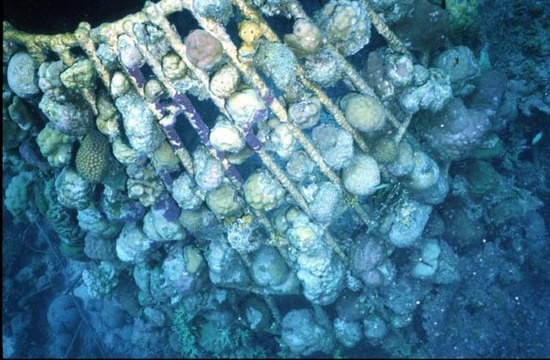2 Sep 2011, Gizmodo
The world’s coral reefs are in trouble. Not just from localized over-fishing and habitat destruction, but worldwide climate change as well. The solution—electrified artificial reefs, of course.
Biorock starts out as a Rebar skeleton structure or electrically-conductive wire mesh, called a Coral Ark. It’s partially sunken or anchored into the seafloor with a solar panel floating on the surface above it, which provides a steady electrical current. As electricity (an exceptionally low voltage, completely safe for swimmers and marine life alike) flows through the structure, accretion occurs—essentially, the salt water electrolyzes, causing calcium carbonate and magnesium hydroxide to form on the cathode—coating the Ark with a natural concrete material very similar to that of clam shells. As long as the current continues to flow, these structures can grow indefinitely—at a rate of 5cm annually—as precipitated materials add to the structure’s rigidity and will even repair themselves if damaged.
Marine animals from oysters to octopi are immediately attracted to these structures—not only for the shade and protection they offer, but also by the weak electrical fields they give off—and will often begin to colonize them within days of installation. Divers also transplant coral fragments from other reefs onto the structure where they use the limestone accretion process to dramatically increase the rate at which their own colonies grow—like, three to five times faster. Other attached organisms like clams and oysters also experience accelerated growth from the accretion process. The electrolysis also significantly increases the coral’s resistance to environmental stresses like pollution and global warming (though these benefits are lost if the power ever cuts out).
As these structures solidify on the seafloor and start to more closely resemble natural reefs, they begin to provide the same benefits of natural reefs—greater resistance to the incoming wave actions reduces the energy with which each wave hits the beach, allowing more suspended sand particles to be dropped on the beach. That slows—and in some cases, even reverses—erosion, as well as increases the amount of particulates in the water (more plankton and Zooxanthella, which make up the base of the food chain), which in turn, attracts even more marine life in high densities.
The benefits of Coral Arks are not limited to wildlife, of course. Local fishermen are able to create sustainable harvesting schemes for the fish, lobster, and oyster stocks the Arks produce, while Ecotourism outfits benefit from the hoards of free-swimming marine life. The structures themselves—on account of their self-healing properties and the fact that they’re cheaper to produce than traditional concrete—also make excellent breakwaters.
The Banyan Tree Ihuru Tourist Resort in the Maldives, for example, had a huge problem with erosion on its beaches. And by huge, I mean the entire beach was in danger of vanishing. Their initial plan to encircle the island resort in sandbags failed as waves quickly shredded them. But, when the resort owners installed Coral Arks along a 140 length of seafloor, the beach grew back. 50 feet in just two years. The resort is now planning to ring the island with a “necklace” of Coral Arks.



